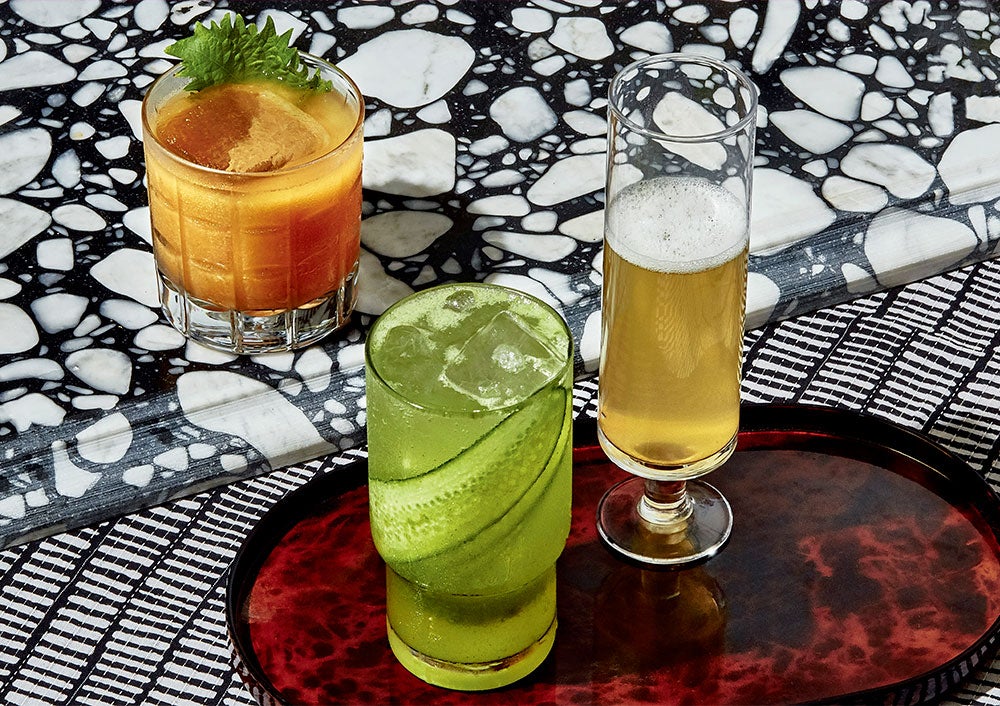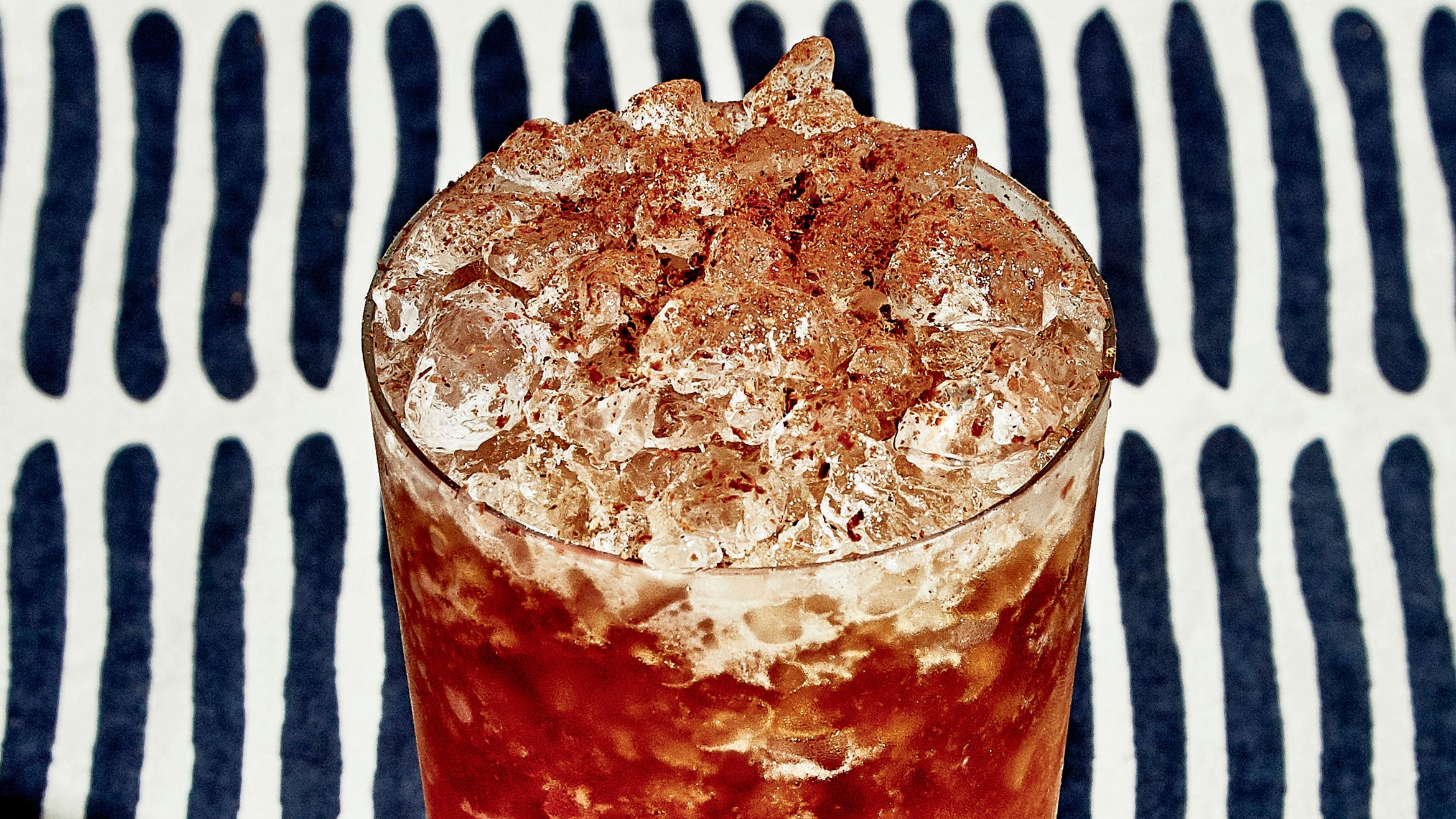
In a new book, Good Drinks, Julia Bainbridge gives alcohol-free cocktails (but don’t call them “mocktails”) the close-up they deserve.
The names, oh, the names. Mocktail, virgin, soft drink (so ’80s!), zero proof, neutral, zero percent, proofless, temperance bevies. In aggregate, proper drinks, good drinks, served without alcohol, have done a pretty poor job at marketing themselves to the general population. The term “mocktail” has caused a mockery, and it’s been tough to write about them with a straight face for…basically ever. But thanks to seasoned editor and journalist Julia Bainbridge, the often poorly covered world of NA drinking is brought into tight focus in a book, Good Drinks, featuring recipes from the brightest bartenders around America.
About the recipes: Many are challenging. Many are also worth the effort. While doing research for the book, Bainbridge visited 29 states to report on not just the innovation happening with these good drinks, but also the mood of bartenders going zero proof. She openly admits that some drinks require much more planning and effort than others, and that even at a baseline, these aren’t simple two-part creations.

Julia Bainbridge is the author of Good Drinks.
Some drinks require steeping tea or infusions, while others lean more into cold-brew coffee and souped-up colas. None are boring. The Cherry, Ginger and Coconut Cream Ale from Richmond, Virginia, café Pomona includes ginger beer, tart cherry juice, and a homemade vanilla-coconut cream. A Padova Spritz from Tobin Shea of Redbird in Los Angeles features beautifully bitter orange chinotto Italian soda, red verjus, and soda water. Bainbridge has wisely provided a recipe key, rating difficulty on a scale of one to four, in an informative, though brisk, introduction that sets the scene with words about tools, ingredients, bitters, fermentation, and ice.
Sobriety, a topic of great significance to many of the bartenders interviewed, is not treated as an elephant on the barstool, but addressed through the author’s own experiences, as well as through the words of the bartenders in the headnotes. This is a book about good drinks, but also about drinking better and feeling good before, during, and after consumption—a refrain held throughout the book and in this email interview with the author. I consider Julia a friend and colleague, and I’ve been hearing about this book for years. To say it surprised me is an understatement. Good Drinks is an important work, and it’s pushing modern drinkmaking, be it at the bar or on the home patio, into exciting territory. The mocktail is dead—long live the good drink.
What does, and doesn’t, alcohol add to a drink? In the cases of NA drinks, how is alcohol replaced to make this drink . . . a drink?
Alcohol adds a lot: It provides structure and complexity, and it’s often pleasantly bitter and bracing. It’s what gives a cocktail backbone, in my mind. But! That doesn’t mean you can’t have a delicious drink without it. And I don’t see it as removing alcohol and replacing the volume with something else; that doesn’t work. I see it instead as being inspired by a classic cocktail and trying to deliver a version of that experience without alcohol.
And, really, that’s what I think you should always be going for when making a drink: What are you trying to deliver? A flavor? A texture? A mood? A journey? Start there, then experiment, and see what suits your tastes. As bartender Ryan Chetiyawardana told me, “It’s not about making a drink minus booze. It’s about taking the care to make a balanced drink, and it happens not to have booze.”
You write about the “IKEA effect” as it pertains to the pleasure of making a drink—versus cracking open a can of Spindrift. Make the case for making your own.
The IKEA effect is fascinating, right? When participants in the study assembled IKEA boxes, folded origami, or built sets of LEGOs themselves, they valued the end product more highly than when others did the work for them. What’s more, the study showed that effort without completion does not increase valuation. So, I take this to mean: If you put in the work, you might even enjoy your drink more—and stick with it!
I brought this up in the introduction because, while some recipes in the book are easily accessible, for others, you’re going to have to order gentian root and raspberry vinegar. Then, you’re going to have to roll up your sleeves and hone your chef’s knife. Hopefully, as more sophisticated products come onto the market (and they are!), you’ll be able to do more opening and pouring and less sourcing, slicing, steeping, and juicing; but I, for one, like the tinkering. Until recently, nonalcoholic mixed drinks have been treated as afterthoughts. A higher level of effort and care anoints them as proper drinks.
How do these drinks span occasions throughout the day—from lunchtime to late night? Are there drinks of many levels? Caffeinated? Less sugar?
I assessed the difficulty of each recipe and assigned it a rating accordingly. That way, you can get an immediate sense of what each drink requires without having to read the entire page (or pages, in some cases). Save the labor-intensive projects for when you have the time and energy, and go for lower effort when you want a quicker fix.
For those who might be cutting back on alcohol for fitness reasons, know that some of the recipes happen to be low on sugar and calories, but many are not. Some are caffeinated, and some are not. I don’t make special notes of which are which; you just have to read the ingredient list. These drinks aren’t for cleansing; they’re for pleasure!

How has nonalcoholic beer gotten good?
De-alcoholizing “normal” beer, a process that adversely affects flavor, was the method of choice until recently, when makers started playing around with technique. In the case of Brooklyn Brewery, that effort was the result of consumer demand; the company started selling an excellent hoppy, nonalcoholic lager called Brooklyn Special Effects in the States last year, after a lot of trial and error in the lab. In the case of Athletic Brewing Company, owner Bill Shufelt’s motivation was more personal: He removed alcohol from his life, and he wanted something better than St. Pauli Girl. He and brewer John Walker played with newly discovered yeast strains that produce limited amounts of alcohol, ending up with a fully fermented beer that’s under 0.5 percent ABV. In other words, there was no need to adulterate the liquid at the end of the process.
What about NA wine?
Wine will be the next thing, I think. There aren’t many good nonalcoholic wines out there, perhaps because enough people aren’t trying, perhaps because it’s such a commitment. Athletic’s beers are a two-week turnaround. With wine, there’s a longer aging and fermentation time. There’s a seasonal harvest as opposed to access to water, hops, barley, and yeast. You would have to devote some tanks to the nonalcoholic wines, which would ultimately sell for less than the regular ones—so it hasn’t been economically viable yet. But, as this alcohol-free space grows and consumers want more of it, perhaps it will be. It just needs people to thoughtfully approach it, rather than taking a full-strength wine and blasting it through an industrial de-alc machine. So, we’ll see!
You write a bit about bitters and soda. How has this call at the bar become so popular, and why is it a great thing to drink at home?
In the United States, wider acceptance of bitterness has been well documented: There has been increasing interest in dark chocolate, cruciferous vegetables, hoppy IPAs, and Italian amaros. And I think it’s a sugar-free way to flavor your seltzer that requires a couple dashes of a bottle that lasts forever. Right?
Is there a flavor trend on the horizon? What aren’t we tasting that you think we will be tasting in the future?
I anticipate a trend less in flavor than in approach. Right now, there are still a number of bartenders relating their nonalcoholic cocktails to those with booze, because that’s an area in which they’re comfortable. But, just as vegetarian dishes served in nonvegetarian restaurants have evolved from platters comprised of whatever sides went with the meat entrées, then to mimicking meat, and, finally, to being treated as their own things, people will lean into the idea of these drinks being nonalcoholic. They’ll take more care with sourcing their ingredients, and they’ll approach drink-making from a culinary standpoint, working to understand what transformations like fermentation can do. I imagine, too, that some forward-thinking bartenders will develop nonalcoholic classics or some kind of templates for other bars and restaurants—ones that might not have the resources to experiment themselves—to follow.
Cold-brew coffee is used in some really cool ways in Good Drinks. What are your favorites?
Matt! How could I possibly pick a favorite?! What I’ll say about the ingredient is that I love the bitterness and the gravity it brings to the mix.
Sobriety is not explicitly called out as the motivation for these drinks, but there’s a clear and obvious joyfulness that comes from staying away from booze. What did you learn about sobriety and the bartenders you interviewed? Is it becoming more popular in the trade, but also in culture?
From my own personal experience, I can say that I’m better to the people in my life when alcohol isn’t around. My feet are planted more firmly on the ground. My mind is clearer. I look better. I feel better. I sleep better. I’m a better lover (no joke!). And I don’t feel like I’m missing out on anything—in fact, I remember more, and so the joyful memories sustain me longer. And, as this book shows, there’s never been a better time to be a nondrinker. There are so many *good drinks* out there!
I’m not anti-alcohol, and I don’t want to demonize it; I just don’t happen to have a healthy relationship with it. (And, for what it’s worth, I don’t identify as sober. I don’t drink alcohol, but I consume cannabis in various forms.)
That said, I wouldn’t purport to be able to answer whether or not people are, at large, drinking less, especially because the pandemic has shaken things up. (Nationwide, alcohol sales were up 55 percent the week ending March 21, 2020, compared to the previous year, according to Nielsen data, and there’s little to no data on trends toward moderation or abstinence this year.) I do seem to hear more about moderation these days, but that could be because I’ve relatively recently attached myself to this topic of nonalcoholic drinking. And I do think that, as cannabis legalization spreads, it will compete with alcohol as a go-to stress reliever or social aid. But, as of last year, alcohol-related deaths had doubled in the United States according to the journal Alcoholism: Clinical and Experimental Research, and that’s likely an undercount. The number of deaths from alcohol also spiked after the 2008 Great Recession, and, while some are choosing to forgo booze in order to feel a greater sense of control, I’m concerned about how others will continue to deal with the political and environmental distress we’re all experiencing. Researchers from the National Institute on Alcohol Abuse and Alcoholism found that people are drinking more in one sitting, and they’re drinking stronger drinks—this was before COVID.
If it’s true that more people are moderating, I’m interested in why. Why are we questioning our drinking? What does that say about our values? Might society change for the good—meaning not drinking is more normalized, and America’s drinking problem becomes less of one—if we continue to have this conversation?
As for the industry, I’ve gotten some flak for commenting on this before, because the hospitality workforce is still rife with addiction, but I do see a change. There’s still a long way to go, but there are conversations taking place. I see some restaurant owners and managers trying to build some kind of infrastructure to better address the health of their workers. Some have found ways—even if it’s something as small as realizing the trade-off between efficiency and connection, and deciding to take time from prep work in order to check in with their employees—and others have not.
It looks a lot of ways: I know plenty of bartenders who are successfully maintaining their sobriety while working in the industry, I know plenty who are not, and I know plenty of others who decided that the healthiest move was to change careers. But I often think about something Jim Meehan said at the first annual symposium for P(OUR), an organization formed in 2016 to bring together “bartenders, baristas, sommeliers, brewers, winemakers, distillers and drinks manufacturers . . . to discuss the past, present and future of drink,” as its website states. Speaking to a group of fellow bartenders, most of them younger, he said: “Chefs—and all the people we work with—they work really hard . . . and the partying is something we all do to blow off steam, but it’s not healthy . . . After twenty years of not taking care of myself, I can’t party like I used to, and I feel self-conscious about it, and I think that’s fucked up. I don’t think that I should have to party, have to do shots, have to drink with you guys until six o’clock [in the morning] to belong.” He finished his talk with a call to action: to not only recognize that “we’re not treating each other very well,” but also to make healthier choices like drinking less booze and exercising, and to inspire others to do the same.
This interview has been condensed and edited for clarity. Above author photo by Theodore Samuels.

4 RECIPES WE ENJOY FROM GOOD DRINKS
Espresso with Tonic and Lime
This drink from Bon Appétit contributor Rick Martinez makes a really great case for why tonic in the morning is what more of us should be doing.
The NYC Special
According to this drink’s creator, Lainey Collum, of the since-closed restaurant The Pass & Provisions, it represents the melting pot that is Houston, Texas: Vietnamese-style iced coffee, Mexican coffee inspiring the cinnamon, and American Coca-Cola.
Don’t Touch My Car Keys
According to this drink’s inventor, Shelby Allison of Chicago’s Lost Lake, the vibe is coconut LaCroix with bitters—but amplified to 1,000.
Change of Address
Eric Nelson of Eem in Portland, Oregon, doctors everyday Coca-Cola with lemon juice, maple syrup, and savory soy sauce.
MORE BOOKS TO BUY, READ, AND COOK FROM:
We recently caught up with Paula Forbes, who runs the very cool cookbook newsletter Stained Page News. In the interview, she names some of the season’s best.
Chef Marcus Samuelsson has teamed up with writer Osayi Endolyn in The Rise: Black Cooks and the Soul of American Food, with the goal of highlighting “the diverse deliciousness of Black cooking today.” We cannot wait to read this.
We’re lucky at have been given a sneak peek of Claire Saffitz’s debut cookbook, Dessert Person—and let us just say, it’s already one of our favorites of the past couple years. We’ll be interviewing her in a couple weeks. There’s lots to ask.
Did you read Lukas Volger’s story on TASTE about corn jumping off the cob and into tofu? It’s great, as is his cookbook, Start Simple.
We caught up with Deuki Hong, a chef based in San Francisco and a coauthor of Koreatown: A Cookbook.
Here are a couple great fall cookbooks roundups from Eater and Chowhound.